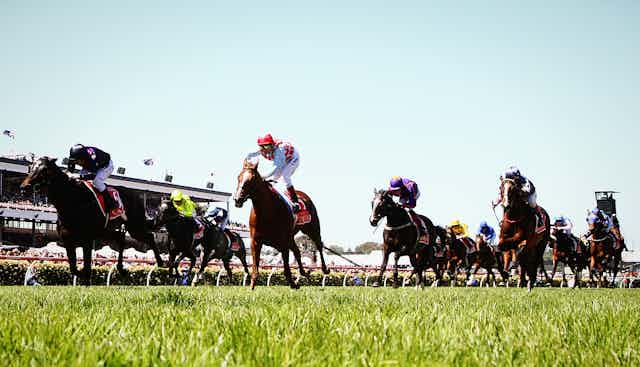If you’re looking for a definitive answer on who will win the Melbourne Cup – the world’s most prestigious two-mile handicap – I’m afraid I’m going to leave you sorely disappointed.
What I can offer is a quick look through the dataset of previous Melbourne Cup champions to identify any common features of the horses who crossed the line first, and to see which of this year’s entrants have those traits in common.
No country for old mares
The most striking trend that jumps out of the dataset of past winners is simple: age matters. In the 153 previous races, only 12 horses aged seven years or above have ever taken home the trophy.
What makes this observation particularly intriguing in the context of the 2014 cup is that four of the ten most fancied runners – including the clear favourite Admire Rakti are all seven-year-olds.
Even more striking is that another of the more favoured entrants, Red Cadeaux, is a nine-year-old. No horse that old has ever been crowned champion.

In short, history suggests that the Melbourne Cup really is a race which favours younger horses – 78% of champions have been four-, five- or six-year-olds.
That’s not to say that this year’s highly-backed elder statesmen won’t deliver on the day, but past precedent suggests that it’s a tough ask.
The weight of history
As with all handicap races, each horse in the Melbourne Cup is assigned a minimum weight (including jockey, saddle and any necessary ballast) which must be carried.
Horses displaying stronger form coming into the race are assigned heavier loads to even out the field slightly.
Since metric weights were first assigned in 1972, the average handicap of a winning horse has been between 53kg and 54kg. Each of the past six winners has run with between 51kg and 55kg.
Much to his owner’s displeasure, this year’s favourite Admire Rakti has been assigned a handicap weight of 58.5kg.
In the metric era, no horse has ever won carrying more than this. In fact, the only horses to win carrying more than 57kg have been repeat winners – Think Big carried 58.5kg to his second consecutive success in 1975 and the final of Makybe Diva’s 2003-2005 hat-trick of victories was achieved carrying 58kg.
The most recent first-time winner to carry more than 58kg was way back in 1954.
No barriers to success
Punters scouring the barrier draw for any clues as to who might triumph will not get much help. Conventional wisdom suggests that higher numbered barriers – those with starting positions wider on the track – are a disadvantage, with the horse potentially facing a tougher task to manoeuvre into a favourable racing line.
The stats really don’t support that view at all. For example, barrier 21 has started three victors in the past 30 years.
In fact, the overall distribution of how many times each barrier’s horse has gone on to win is statistically indistinguishable from a purely unbiased random draw.
But if you really are a superstitious type (and many gamblers are) you might choose to steer clear of the poor nag in barrier 18. Since the barrier stalls were first used back in 1924, unlucky number 18 hasn’t seen a single success. Mr O'Ceirin is attempting to break that luckless streak this year after Sea Moon – who was initially picked for barrier 18 – was scratched.
What’s in a number?
The often-cited barrier draw might well be a red herring, but that’s not to say that there aren’t some numbers that can help predict the victor.
The number on each horse’s saddlecloth gives a huge clue as to whether or not it’s a probable contender. In fact, the history books show that 65% of champions have worn a number between 1 and 12.
This isn’t just a statistical quirk, either. The numbers are assigned based on the handicap weights. The horse carrying the heaviest weight (often, as with this year, the favourite) has saddlecloth 1 and the horse with the lightest handicap wears 24.
In that regard numbers 1-12 are worn by the dozen horses which the Chief Handicapper has deemed the strongest on paper.
Interestingly, though, within each half of the field the trend is much weaker. Since 1877, 21 winners have worn 1-3 (an average of seven winners per number) and 64 winners have worn 4-12 (a very similar average of 7.33 winners per saddlecloth).
For horses numbered outside this top dozen, I’m afraid the history books really don’t provide happy reading. The 12 highest saddlecloths have accounted for an average of fewer than four victories each, barely half the success rate of the lower numbers.
So who to pick on this year’s race?
It’s an old sporting cliché to say that records are made to be broken, but if this year’s favourite, Admire Rakti, is to take home the cup, he’ll have to overcome historically large obstacles in terms of age and weight.
Even casting your eye further down the list of favourites, many of the more fancied runners are either carrying more weight or have clocked up a few more birthdays than previous winners.
All of this adds up to a particularly unpredictable race day in 2014. Either it’s a year for historical trends to mean little or perhaps the time is ripe for a plucky outsider to steal a surprise success.
So who do I think you should hope to get in any lucky dip sweepstake this year? Well, really, that’s completely up to you.
As far as I’m concerned, provided you get some time off work (if you’re not on a public holiday in Victoria) and a good feed or drink on Tuesday afternoon, then whichever horse’s name is on your ticket, you really can’t complain.
Best of luck to you all for the big race.

